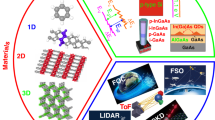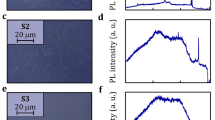Abstract
Impact ionization, which supports carrier multiplication, is promising for applications in single photon detection1 and sharp threshold swing field effect devices2. However, initiating the impact ionization of avalanche breakdown requires a high applied electric field in a long active region, which hampers carrier multiplication with a high gain, low bias and superior noise performance3,4. Here we report the observation of ballistic avalanche phenomena in sub-mean free path (MFP) scaled vertical InSe/black phosphorus (BP)5,6,7,8,9 heterostructures10. We use these heterojunctions to fabricate avalanche photodetectors (APDs) with a sensitive mid-infrared light detection (4 μm wavelength) and impact ionization transistors with a steep subthreshold swing (<0.25 mV dec–1). The devices show a low avalanche threshold (<1 V), low noise figure and distinctive density spectral shape. Our transport measurements suggest that the breakdown originates from a ballistic avalanche phenomenon, where the sub-MFP BP channel support the lattice impact ionization by electrons and holes and the abrupt current amplification without scattering from the obstacles in a deterministic nature. Our results provide new strategies for the development of advanced photodetectors1,11,12 via efficient carrier manipulation at the nanoscale.
This is a preview of subscription content, access via your institution
Access options
Access Nature and 54 other Nature Portfolio journals
Get Nature+, our best-value online-access subscription
$29.99 / 30 days
cancel any time
Subscribe to this journal
Receive 12 print issues and online access
$259.00 per year
only $21.58 per issue
Buy this article
- Purchase on Springer Link
- Instant access to full article PDF
Prices may be subject to local taxes which are calculated during checkout




Similar content being viewed by others
Data availability
The data that support the findings of this study are available from the corresponding authors on reasonable request.
References
Dam, J. S., Tidemand-Lichtenberg, P. & Pedersen, C. Room-temperature mid-infrared single-photon spectral imaging. Nat. Photon. 6, 788–793 (2012).
Gopalakrishnan, K., Griffin, P. B. & Plummer, J. D. I-MOS: a novel semiconductor device with a subthreshold slope lower than kT/q. Tech. Digest Int. Electron Dev. Meet. 289–292 (IEEE, 2002).
McIntyre, R. J. The distribution of gains in uniformly multiplying avalanche photodiodes: theory. IEEE Trans. Electron Devices 19, 703–713 (1972).
Capasso, F. Band-gap engineering: from physics and materials to new semiconductor devices. Science 235, 172–177 (1987).
Bandurin, D. A. et al. High electron mobility, quantum Hall effect and anomalous optical response in atomically thin InSe. Nat. Nanotech. 12, 223–227 (2017).
Xia, F., Wang, H. & Jia, Y. Rediscovering black phosphorus as an anisotropic layered material for optoelectronics and electronics. Nat. Commun. 5, 4458 (2014).
Engel, M., Steiner, M. & Avouris, P. Black phosphorus photodetector for multispectral, high-resolution imaging. Nano Lett. 14, 6414–6417 (2014).
Yuan, H. et al. Polarization-sensitive broadband photodetector using a black phosphorus vertical p–n junction. Nat. Nanotech. 10, 707–713 (2015).
Youngblood, N., Chen, C., Koester, S. J. & Li, M. Waveguide-integrated black phosphorus photodetector with high responsivity and low dark current. Nat. Photon. 9, 247–252 (2015).
Yu, W. J. et al. Vertically stacked multi-heterostructures of layered materials for logic transistors and complementary inverters. Nat. Mater. 12, 246–252 (2013).
Weibring, P., Edner, H. & Svanberg, S. Versatile mobile lidar system for environmental monitoring. Appl. Optics 42, 3583–3594 (2003).
Zhao, G. et al. Mobile lidar system for environmental monitoring. Appl. Optics 56, 1506–1516 (2017).
Li, L. et al. Black phosphorus field-effect transistors. Nat. Nanotech. 9, 372–377 (2014).
Liu, H. et al. Phosphorene: an unexplored 2D semiconductor with a high hole mobility. ACS Nano 8, 4033–4041 (2014).
Koenig, S. P., Doganov, R. A., Schmidt, H., Castro Neto, A. H. & Özyilmaz, B. Electric field effect in ultrathin black phosphorus. Appl. Phys. Lett. 104, 103106 (2014).
Hayden, O., Agarwal, R. & Lieber, C. M. Nanoscale avalanche photodiodes for highly sensitive and spatially resolved photon detection. Nat. Mater. 5, 352–356 (2006).
Bulgarini, G. et al. Avalanche amplification of a single exciton in a semiconductor nanowire. Nat. Photon. 6, 455–458 (2012).
Hadfield, R. H. Single-photon detectors for optical quantum information applications. Nat. Photon. 3, 696–705 (2009).
Yuan, P. et al. A new look at impact ionization—Part II: gain and noise in short avalanche photodiodes. IEEE Trans. Electron Devices 46, 1632–1639 (1999).
Dutta, P. & Horn, P. M. Low-frequency fluctuations in solids: 1/f noise. Rev. Mod. Phys. 53, 497 (1981).
Crowell, C. R. & Sze, S. M. Temperature dependence of avalanche multiplication in semiconductors. Appl. Phys. Lett. 9, 242–244 (1966).
Hollenhorst, J. N. Ballistic avalanche photodiodes: ultralow noise avalanche diodes with nearly equal ionization probabilities. Appl. Phys. Lett. 49, 516–518 (1986).
Gu, Y. & Choa, F. S. Low bias, low noise single-avalanche-stage APDs. IEEE Lasers Electro-Optics Soc. 2, 1001–1002 (2003).
Jindal, R. P. Approaching fundamental limits on signal detection. IEEE Trans. Electron Dev. 41, 2133–2138 (1994).
Rodin, A. S. et al. Tunable optical properties of multilayer black phosphorus thin films. Phys. Rev. B 90, 075434 (2014).
Shin, Y. S. et al. Mobility engineering in vertical field effect transistors based on van der Waals heterostructures. Adv. Mater. 30, 1704435 (2018).
Liang, W. et al. Fabry–Perot interference in a nanotube electron waveguide. Nature 411, 665–669 (2001).
Javey, A., Guo, J., Wang, Q., Lundstrom, M. & Dai, H. Ballistic carbon nanotube field-effect transistors. Nature 424, 654–657 (2003).
Allen, M. T. et al. Observation of electron coherence and Fabry–Perot standing waves at a graphene edge. Nano Lett. 17, 7380–7386 (2017).
Miao, F. et al. Phase-coherent transport in graphene quantum billiards. Science 317, 1530–1533 (2007).
Heyd, J., Scuseria, G. E. & Ernzerhof, M. Hybrid functionals based on a screened Coulomb potential. J. Chem. Phys. 118, 8207–8215 (2003).
Kresse, G. & Furthmüller, J. Efficiency of ab-initio total energy calculations for metals and semiconductors using a plane-wave basis set. Comp. Mater. Sci. 6, 15–50 (1996).
Kresse, G. & Furthmüller, J. Efficient iterative schemes for ab initio total-energy calculations using a plane-wave basis set. Phys. Rev. B 54, 11169–11186 (1996).
Pack, J. D. & Monkhorst, H. J. Special points for Brillouin-zone integrations. Phys. Rev. B 13, 5188–5192 (1976).
Narita, S. et al. Far-infrared cyclotron resonance absorptions in black phosphorus single crystals. J. Phys. Soc. Jpn 52, 3544–3553 (1983).
Acknowledgements
This project was primarily supported by the National Key Basic Research Program of China (grant nos 2018YFA0307200, 2015CB921600, 2013CBA01603 and 2018YFA0209100), the National Natural Science Foundation of China (grant nos 61775092, 61625402, 61574076, 11374142, 11574136, 11534010, 91750109 and 61725505), the Key Research Program of Frontier Sciences CAS (grant no. QYZDY-SSW-SLH021), the State Key Laboratory of Precision Measurement Technology and Instruments Fund for open topics, the Fundamental Research Funds for the Central Universities and the Collaborative Innovation Centre of Advanced Microstructures.
Author information
Authors and Affiliations
Contributions
X.W., F.M. and A.G. conceived and designed the experiments. A.G. fabricated the devices. A.G., Y.W., J.Z., G.Y. and T.C. conducted the transport measurements. A.G., J.L., W.H. and D.S. conducted the photoresponse measurements. Z.Z. and W.C. performed the DFT calculations. N.W. and X.C. helped to grow the BP crystals. A.G., X.W. and F.M. analysed the data and wrote the manuscript. X.W., F.M. and Y.S. supervised the research. All the authors discussed the obtained results.
Corresponding authors
Ethics declarations
Competing interests
The authors declare no competing interests.
Additional information
Publisher’s note: Springer Nature remains neutral with regard to jurisdictional claims in published maps and institutional affiliations.
Supplementary information
Supplementary information
Observation of ballistic avalanche phenomena in nanoscale vertical InSe/BP heterostructures
Rights and permissions
About this article
Cite this article
Gao, A., Lai, J., Wang, Y. et al. Observation of ballistic avalanche phenomena in nanoscale vertical InSe/BP heterostructures. Nat. Nanotechnol. 14, 217–222 (2019). https://doi.org/10.1038/s41565-018-0348-z
Received:
Accepted:
Published:
Issue Date:
DOI: https://doi.org/10.1038/s41565-018-0348-z
This article is cited by
-
Anisotropy of impact ionization in WSe2 field effect transistors
Nano Convergence (2023)
-
Low-dimensional wide-bandgap semiconductors for UV photodetectors
Nature Reviews Materials (2023)
-
Infrared avalanche photodiodes from bulk to 2D materials
Light: Science & Applications (2023)
-
Photonic van der Waals integration from 2D materials to 3D nanomembranes
Nature Reviews Materials (2023)
-
New materials and designs for 2D-based infrared photodetectors
Nano Research (2023)



